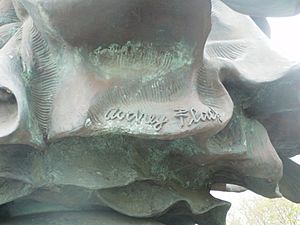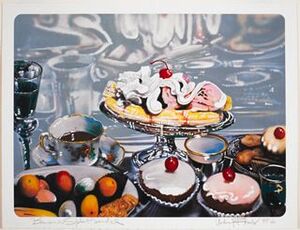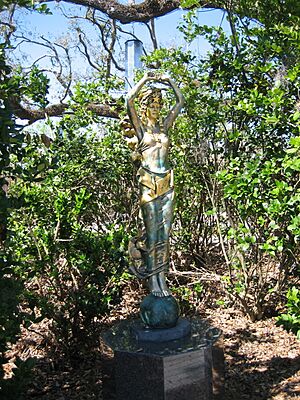Audrey Flack facts for kids
Quick facts for kids
Audrey Flack
|
|
|---|---|

Artist's signature on bronze
|
|
| Born | May 30, 1931 New York City, U.S.
|
| Died | June 28, 2024 (aged 93) |
| Education | The High School of Music & Art New York University Institute of Fine Arts Yale University Cooper Union |
| Known for | Painting, Sculpture |
| Movement | Photorealism |
| Spouse(s) | H.Robert Marcus |
Audrey Flack (May 30, 1931 – June 28, 2024) was an American artist. She was a pioneer in a style of art called photorealism. Her artwork included paintings, prints, sculptures, and photographs.
Audrey Flack earned many degrees from top schools. She studied at Cooper Union and Yale University. She also learned about art history at New York University. In 2015, she received a special honorary degree from Clark University.
Her art is shown in famous museums around the world. These include the Museum of Modern Art and the Metropolitan Museum of Art. Her photorealistic paintings were the first of their kind bought by the Museum of Modern Art. Her unique style still inspires many artists today.
Contents
Audrey Flack's Early Life and Education
Audrey Flack went to the High School of Music & Art in New York. She studied fine arts from 1948 to 1953. One of her teachers was the famous artist Josef Albers.
She earned a graduate degree from Cooper Union in New York City. She also received a Bachelor of Fine Arts from Yale University. Later, she studied art history at New York University.
Audrey Flack's Art Career

In the 1950s, Audrey Flack started with a style called abstract expressionism. But over time, she moved towards New Realism. By the 1960s, she developed her unique photorealism style. She wanted her art to connect with people easily.
In 1966, she became the first photorealist painter to have her work added to the Museum of Modern Art collection. From 1976 to 1978, she painted her Vanitas series. This included her well-known piece, Marilyn.
Art critics noted how photorealism used photos to create paintings. Artists like Flack would often use pictures to make their art look like real photographs.
In the early 1980s, Flack started making sculptures instead of paintings. She said she wanted to create "something solid, real, tangible." She felt that photorealism had become too limiting for her. She found new ideas from Baroque art, which is a very detailed and dramatic style.
Her artwork is kept in museums worldwide. These include the Metropolitan Museum of Art and the National Gallery of Australia. In 1986, Flack wrote a book called Art & Soul: Notes on Creating. It shared her thoughts about being an artist.
Her image was also part of a famous 1972 poster. It was called Some Living American Women Artists. In 2023, her work was shown in a London art exhibition.
What is Photorealism?
Audrey Flack is most famous for her photorealist paintings. She was one of the first artists to use photographs as a base for her art. This style was inspired by Pop Art. It shows real, everyday things like ads, cars, and makeup.
Flack's work often featured common household items. These included lipstick tubes, perfume bottles, and fruit. She would arrange these objects like a still life on a table. Her paintings sometimes included real historical events. Examples are World War II (Vanitas) and Kennedy Motorcade. Women were also often the main subject of her photorealist paintings.
Audrey Flack's Sculptures


Audrey Flack's sculptures are sometimes not as well known as her paintings. She taught herself how to make sculptures. In her sculptures, she often included themes of religion and mythology. This was different from the everyday subjects in her paintings.
Her sculptures often showed strong female figures. These included heroic women and goddesses. They were not just traditionally feminine. Instead, they looked athletic, older, and powerful. Flack described them as "goddesses in everywoman."
In the early 1990s, Flack was asked to create a large bronze statue. It was for Catherine of Braganza, after whom the borough of Queens is named. The statue would have been very tall, like a nine-story building. It was meant to be placed in Long Island City, New York.
However, the project was never fully built. Some people protested because Queen Catherine had historical ties to the Transatlantic Slave Trade. Flack still worked on the project. She wanted to show Catherine as biracial. This would reflect her Portuguese background and honor the many different cultures in Queens.
Audrey Flack's Death
Audrey Flack passed away on June 28th in Southampton, New York. She was 93 years old. Her husband, Robert Marcus, had passed away before her. She is survived by her two daughters, Hannah and Melissa.
See also
 In Spanish: Audrey Flack para niños
In Spanish: Audrey Flack para niños

